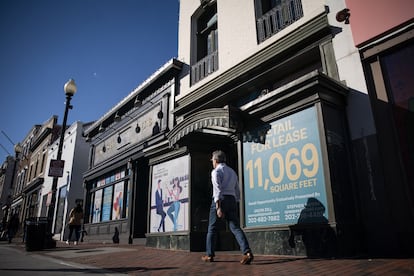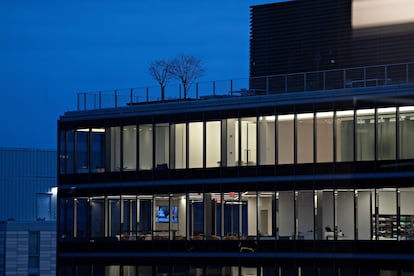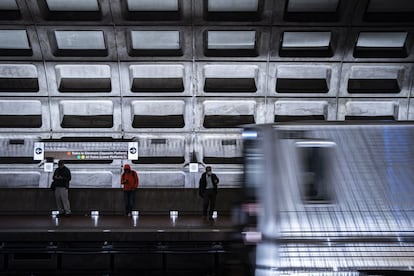The battle to save America’s downtowns: ‘This looks like a slow death’
Many U.S. cities are struggling to recover from the blow of the Covid pandemic and the generalization of teleworking, with Washington and San Francisco among the hardest hit


Benson Jewelers had been operating in the “mid-range” jewelry business in Washington since 1939. A couple of weeks ago the company, which Ken Stein inherited from his father, was forced to close the store it had occupied since 2007 on F Street, a stone’s throw from the White House. There were various reasons, Stein said on his final day in the now-empty store: times have changed — “women prefer to spend money on travel, not on rings” — but the final straw was “the pandemic, teleworking and the fact that civil servants have not yet returned to the office.” Last Christmas, a period that provides half of the store’s income, it made only $60,000. The rent bill alone amounted to $11,000 a month for 100 square meters. Stein admits that Washington never possessed anything like a vibrant downtown. “But this is something else: this looks like a slow death.”
On this same block alone over the past few months a bank, a restaurant, two clothing stores and a discount department store have disappeared. Jae, whose convenience store is barely holding on, says the trickle of tenant departures is constant. The crisis is so acute that the city’s Democratic mayor, Muriel Bowser, kicked off her third term in January by launching a plan to add 650,000 square meters of apartments by 2028, attracting 15,000 new residents to downtown. But Bowser’s plan faces post-pandemic realities: many government employees, who make up a third of downtown workers, are not enamored by the prospect of full return to an office timetable. Joe Biden’s administration seems unwilling to gamble its short supply of political capital in a showdown with the unions and the Republican Party has begun to lose patience: In February, the Republican-controlled House of Representatives passed a bill to return federal workers to offices and “address the problems of unproductivity resulting from telework.” They called it the Stopping Home Office Work’s Unproductive Problems Act, or SHOW UP.
The debate over the future of America’s downtowns is not unique to the capital, nor is it new: the issue has been present for more than six decades, spanning a series of crises from rising crime to bankruptcy, homelessness and opiates to rampant inequality and gentrification, racial segregation, urban zoning, and the rise of mall culture. The pandemic exacerbated many of these problems, but above all it gave an exponential boost to remote working.
U.S. cities that based their model on an abundance of office workers are now paying the consequences of that decision. “They were ruthlessly organized around efficiency, and that has made them less resilient,” says Harvard economist Edward Glaeser, author of Triumph of the City (2011), a review of the history of “one of humanity’s great creations,” which, he argues, has contributed to mankind’s well-being, intellectual progress and economic growth.

Glaeser published a sequel of sorts, Survival of the City, 10 years later. Co-authored with his colleague David Cutler, it is subtitled “Living and Thriving in the Age of Isolation.” They wrote it based on the idea that the great history of cities overcoming their trials and tribulations is also the story of their victories over the pandemics of the past. In the book, they ask how to recover from the most recent one. And the answer they provide is one of optimism.
“The coronavirus pandemic was a painful process,” Glaeser says during a videoconference interview with EL PAÍS from his office at the university, which he has been attending regularly since the summer of 2021. “But it doesn’t compare to others: for example, the Plague of Justinian, which hammered the final nail in the coffin of the Roman Empire. Recovery in some parts of Europe took a millennium. It won’t be like that this time. Cities resist. And they always bounce back.” As well as Glaeser and Cutler, an army of urban planners, economists, geographers and other experts are busy debating whether this is a full-blown, 1970s-style crisis, or the tail-end of the whiplash caused by the 2008 financial crisis.
A group of such experts have launched the Downtown Recovery project, a study of 52 U.S. and 10 Canadian cities of more than 350,000 inhabitants. In addition to the usual metrics (percentage of vacant offices, use of public transportation and retail spending), they have added analysis of human activity based on cellphone tracking. From this they have extracted a percentage that compares life before the pandemic — the standard for which is 100% — and afterward. Medium-sized cities, thanks to teleworking, favorable taxation, and a greater supply of large houses with room for a home office, have fared better, although real estate pressure is still driving out many of their residents.
Of the downtowns studied, only four, all of them mid-sized, exceed the 100% threshold. Leading the ranking is Salt Lake City in Utah, with a 135% recovery rate over 2019. Washington stands at 73%, while San Francisco scored 31%. “Salt Lake City has become a cluster of technology and innovation,” says Tracy Loh, a metropolitan researcher at the Washington-based Brookings Institution. “Those industries invite clustering, often in a few buildings. The key is to build domiciles near those buildings. The biggest driver for teleworking is living far away. Analyses indicate that shortening commutes encourages the desire to go to the office. If it’s close to you, you may well prefer to go out to get some fresh air.”

San Francisco’s poor planning
But what about Washington and San Francisco? Both rank at the bottom in terms of office occupancy, at just over 40%, according to the “Getting America Back to Work” report updated weekly by New York-based security firm Kastle. Among the indicators used by Kastle is the consumption of the big blue bottles used in water coolers. “San Francisco is paying the consequences of poor policy decisions. Before the pandemic it had many more jobs, around 100,000, than it did housing, which stood at about zero. It’s a very illustrative case of the mistake of not building housing next to offices,” says Loh. “In Washington, the problem is that downtown is the most important job center in the region [which includes parts of the states of Maryland and Virginia]. It’s full of government employees and other workers who live in another jurisdiction. Teleworking is widespread; the streets are empty.”
Mayor Bowser is planning to change that by building housing, but also by converting some of the now-vacant, impersonal office buildings into apartments. It will not be a simple task. “It’s easier to repurpose the older, smaller, European-style ones for residential use. The larger ones, those built since the 1980s, are much more expensive. They don’t have enough windows, or the necessary plumbing for every apartment to have its own bathroom,” says Stanford professor Nicholas Bloom, who was once known as “the prophet of teleworking” until one day, in March 2020, a plague arrived and fulfilled all his prophecies at once. “It will take time to clear excess inventory, because right now 30% of offices in the United States are vacant. The solution is for a lot of space to sit empty, for no new space to be built, and for the surplus to eventually be absorbed.”
Bloom also forecasts that restaurants and stores that catered to workers who now only show up “two or three days a week,” face straitened times. “Spending has dropped by 50%, and it’s moved to the suburbs, so you can expect to have to close 30% of those businesses. In the next five to 10 years, telework will continue to grow, because the technology that drives it will improve: I’m thinking holograms, augmented and virtual reality... We are going through a process of adaptation.” In the short term, Bloom says, it will be painful for all those associated jobs, such as Benson Jewelers. “But in the long run it’s a positive, natural process of creative destruction.”What to do in the meantime? Loh is about to publish a scientific paper laying out some possible remedies: “Build apartments; invest in security, in view of the fact that crime has increased since 2019; create quality public spaces and pedestrian areas; reinvent public transportation, which has been so affected by Covid; invest in growth industries capable of occupying offices, and create hotspots for visitors.”
Paradoxically, the picture that emerges from connecting all these dots looks a lot like a European city. Is this recipe compatible with the ideal of residential suburban life, inseparable from the American Dream? “It will have to be. Surveys show that the millennial and generation Zs prefer to live in walkable communities with access to services,” says Glaeser. “The city of the future will have to be more life-oriented and pleasure-oriented than productivity-oriented. What will save downtowns is that people want to enjoy them, to go out and socialize. European cities have historically been better prepared for that.”

The entertainment equation
Lynne Sagalyn, a real estate expert at Columbia University, concurs that leisure will be an important part of the revival plan. “It’s already happening. If you go to downtown in a city like New York, it’s very hard to find a table in a restaurant. You see a lot of young people. They hang out there to lead a social life that Zoom doesn’t give them. That shows that downtowns represent more than just the health of their office markets.”
Sagalyn wrote a groundbreaking study in the early 1990s entitled Downtown Inc. How America Rebuilds Cities, in which she detailed how private entrepreneurship was pulling American cities out of the hole. She is also optimistic: if it could be done then, it can be done now, she says, while pointing out that cities “have been dying for about 10,000 years.”
A century after the golden age of downtowns in the United States, from Tulsa to Detroit and from Los Angeles to Columbus, it remains to be seen how long it will take this time before Petula Clark’s 1964 pop classic rings true again: The light’s so much brighter there / You can forget all your troubles, forget all your cares / So go downtown / Things will be great when you’re Downtown / No finer place for sure Downtown / Everything’s waiting for you.
Sign up for our weekly newsletter to get more English-language news coverage from EL PAÍS USA Edition
Tu suscripción se está usando en otro dispositivo
¿Quieres añadir otro usuario a tu suscripción?
Si continúas leyendo en este dispositivo, no se podrá leer en el otro.
FlechaTu suscripción se está usando en otro dispositivo y solo puedes acceder a EL PAÍS desde un dispositivo a la vez.
Si quieres compartir tu cuenta, cambia tu suscripción a la modalidad Premium, así podrás añadir otro usuario. Cada uno accederá con su propia cuenta de email, lo que os permitirá personalizar vuestra experiencia en EL PAÍS.
¿Tienes una suscripción de empresa? Accede aquí para contratar más cuentas.
En el caso de no saber quién está usando tu cuenta, te recomendamos cambiar tu contraseña aquí.
Si decides continuar compartiendo tu cuenta, este mensaje se mostrará en tu dispositivo y en el de la otra persona que está usando tu cuenta de forma indefinida, afectando a tu experiencia de lectura. Puedes consultar aquí los términos y condiciones de la suscripción digital.
More information
Archived In
Últimas noticias
Welcome to the post-religion era: The idea of Christianity as the absolute truth has become obsolete
‘I thought you would like it’: The risky sexual practice popularized by TV shows and TikTok
The digitalization of tourism: ‘They promise experiences and gave us the worst possible one’
Mexican peso defies uncertainty with forecasts of a new period of stability in 2026
Most viewed
- Sinaloa Cartel war is taking its toll on Los Chapitos
- Oona Chaplin: ‘I told James Cameron that I was living in a treehouse and starting a permaculture project with a friend’
- Reinhard Genzel, Nobel laureate in physics: ‘One-minute videos will never give you the truth’
- Why the price of coffee has skyrocketed: from Brazilian plantations to specialty coffee houses
- Silver prices are going crazy: This is what’s fueling the rally










































